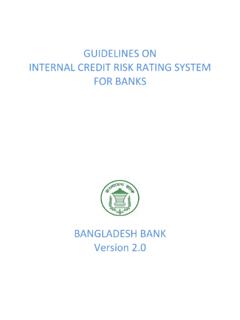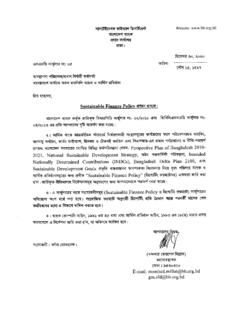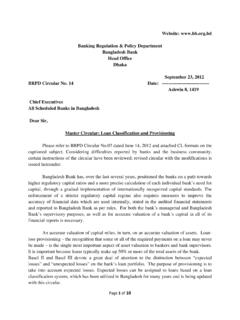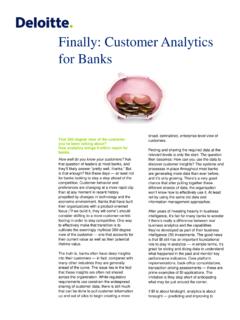Transcription of Guidelines on Electronic Know Your Customer (e-KYC)
1 Page | I Guidelines on Electronic know your Customer (e-KYC) Bangladesh Financial Intelligence Unit 2nd Annex Building, 11th Floor Bangladesh Bank, Motijheel Dhaka-1000. Volume: 01 Dated: December, 2019 Revision date: None II Preface Bangladesh is one of the fastest growing economies in the world and looking forward to transforming itself into a developed economy by 2041. The Sustainable Development Goal (SDG) Agenda -1 (one) emphasizes to put in place a sound policies and gender sensitive development strategies for poverty eradication and Agenda 8(10) of the same urges for capacity building of domestic financial institutions to encourage and expand access to banking, insurance and financial services for all. Financial Action Task Force (FATF), an inter governmental and global standards setting body on combating money laundering and financing of terrorism also encourage jurisdictions to pursue financial inclusion through risk based approach.
2 The Vision 2021 reaffirms the Bangladesh government commitment to provide financial service at doorstep of the citizens in an easy, faster and low cost manner. In this backdrop, implementation of Electronic know your Customer (e-KYC) can contribute to achieve the above mentioned target of SDG Agenda and Vision 2021. Additionally, the National Strategy for prevention of Money Laundering and Combating Financing of Terrorism Strategy 2019-2021 published by the Bangladesh Government also has set a comprehensive strategic objective (Strategy No. 08) to promote FinTech and RegTech, financial inclusion and ensuring cyber security. The action item no. 9 of the strategy has set a deadline to implement e-KYC/Digital KYC by December 2020. Since the digitalization enable easy access of Customer , even from the remote location, into the financial services, this may pose some underlying risk of money laundering, terrorism financing and related criminal activities by abusing financial institutions and its services.
3 As such, while preparing this Guideline relevant international best practices are meticulously consulted. Beside the best practices, a multiagency working group led by Executive Director, Bangladesh Bank along with Bangladesh Financial Intelligence Unit (BFIU) worked since 2017 to test the viability of e-KYC in Bangladesh. Therefore, the working group has completed hands on nationwide pilot project on e-KYC III participated by 18 banks and 01 non-bank financial institutions. This pilot project covers Customer onboarding using biometrics and different technologies, where Customer s identity was checked by using National Identification (NID) card issued by National Identity Registration Wing NIDW) of Election Commission (EC) of Bangladesh. The technologies used in the pilot project were fingerprint devices, face matching devices, artificial intelligence, optical character recognition (both in Bangla and English) and so on.
4 In the pilot project, the average rate of successful on-boarding has been found to be higher for the fingerprint technology than the facial matching technology. The draft report of the pilot project also acknowledged that the success rate of Customer on-boarding through fingerprint and face matching technology might increase based on the institutional capacity and the training. The data provided by the institutions showed that the e-KYC can save time of onboarding from 4-5 days to 5-6 minutes, cost of Customer onboarding and KYC reduces 5-10 times and the growth of business (in particular to the client base) is around 25% compared to the traditional onboarding and KYC mechanism. Therefore, the BFIU issued this Guideline for the financial institutions including banks, non-bank financial institutions, insurance companies, capital market intermediaries, MFS, DFS and the other companies licensed by the Bangladesh Bank under the power conferred in the Section 23(1)(d) of the Money Laundering Prevention Act, 2012 and the Section 15(1)(d) of the Anti Terrorism Act, 2009.
5 The BFIU expects every financial institution to implement this Guideline by December 2020 to enhance their service capacity by reducing cost and time and achieve steady business growth. Subsequently, prevent any misuse of their products, services and delivery channels from money laundering, terrorist financing and relevant predicate crimes. The financial institutions are free to choose required technology and any suggested models mentioned in this Guideline, however, they have to follow every steps of the chosen model. IV Table of Contents 1..1 2. e-KYC 3. Customer on Customer on boarding Customer on boarding by using 11 Required .. 13 Sanctions and other 14 Audit trail of Customer 14 Matching 15 Security .15 Customer on Boarding- by using face Required 18 Sanctions and other 19 Audit trail of Customer V Matching.
6 20 Security 4. Customer on boarding-regular Sanctions and other 23 Audit trail of Customer ..23 Matching 24 Security 5. Other relevant Record 25 Reliance on third 25 Risk 26 27 Transformation of existing clients Profile- Simplified and Sample e-KYC output for simplified Sample e-KYC output for regular Customer Risk Grading Risk Grading VI Abbreviations AI Artificial Intelligence BB Bangladesh Bank BFIU Bangladesh Financial Intelligence Unit BTRC Bangladesh Telecommunication Regulatory Commission CDD Customer Due Diligence CDBL Central Repository of Bangladesh Limited DNFBPs Designated Non-Financial Business and Professions e-KYC Electronic know your Customer FATF Financial Action Task Force KYC know your Customer MFS Mobile Financial Service ML/TF Money Laundering & Terrorism Financing NRA National ML/TF Risk and Vulnerability Assessment NID National Identification Database OCR Optical Characteristic Recognition SDD Simplified Due
7 Diligence SIM Subscriber Identity Module SDG Sustainable Development Goal 2FA Two Factor AuthenticationPage | 1 Introduction Background The concept of know your Customer (KYC) within the financial sector and Designated Non -Financial Business and Professions (DNFBPs) started only few decades back. It has got momentum when FATF came forward with a set of recommendations for prevention of money laundering and financing of terrorism. Within the FATF standards KYC had been emerged as one of the main preventive measures or tools to protect financial institutions abusing from criminal activities. The FATF Recommendation no. 10 requires financial institutions to conduct KYC, Customer Due Diligence (CDD) either simplified or enhanced based on the Customer risk profile as well as on-going CDD measures. It also requires that CDD should be undertaken by the financial institutions while establishing business relationship with Customer .
8 The CDD measures to be taken by the financial institutions as per the FATF standards are as follows: (a) Identifying the Customer and verifying that Customer s identity using reliable, independent source documents, data or information; (b) Identifying the beneficial owner and taking reasonable measures to verify the identity of the beneficial owner, as such that the financial institution is satisfied that it knows who the beneficial owner is. For legal persons and arrangements this should include financial institutions understanding the ownership and control structure of the Customer . (c) Understanding and, as appropriate, obtaining information on the purpose and intended nature of the business relationship; (d) Conducting ongoing due diligence on the business relationship and scrutiny of transactions undertaken throughout the course of that relationship to ensure that the transactions being conducted are consistent with the institution s knowledge of the Customer , their Page | 2 business and risk profile, including, where necessary, the source of fund.
9 The Financial institutions should be required to apply each of the CDD measures and should determine the extent of such measures using a risk-based approach (RBA) in accordance with the Interpretive Notes to this Recommendation. The relevant identification data may be obtained from a public register, from the Customer or from other reliable and independent sources. In 2017, the FATF provided a specific supplement to the 2013 Guidance on AML/CFT Measures and financial inclusion, focusing specifically on CDD and financial inclusion. The Guideline highlights risk mitigation measures that Financial Institutions should apply commensurate with the nature and level of risks identified, to mitigate the risks. It also presents different CDD approaches which can be implemented to facilitate financial inclusion and remove obstacles linked to the verification of the Customer s identity, either a broad understanding of the reliable and independent source of information or simplified due diligence measures.
10 Where the risks of ML and TF are lower, one or more of the digital ID system s basic processes, may be less reliable ( , have a lower assurance level) would still satisfy the requirements of Recommendation 10. FATF standards are applicable for both traditional and digital financial services. The digital financial services cover financial products and services, including payments, transfers, savings, credit, insurance and securities. They are delivered via digital/ Electronic technology such as e-money (initiated either online or on a mobile phone), payment cards and regular bank accounts. In Bangladesh, section 25 of Money Laundering Prevention Act (MLPA), 2012 requires financial institutions to collect complete and correct identity of Customer while establishing business relationship with its potential Customer . The Rule 6 to12 of the Money Laundering Prevention (MLP) Rules 2019 provides a detail framework to conduct Customer due diligence for the financial institutions, where Rule no.






